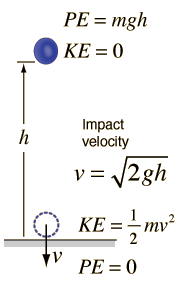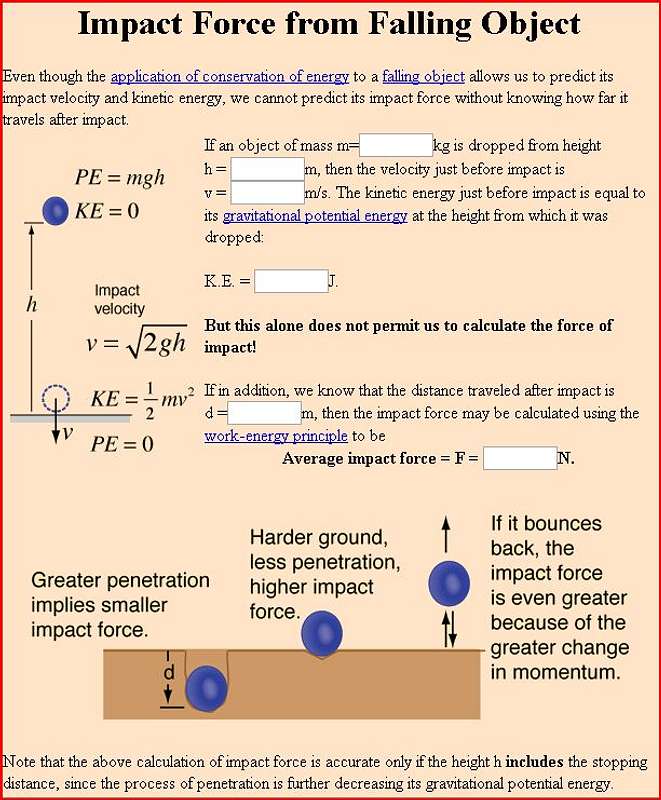Results 1 to 15 of 15
Thread: Whack on the head math!
-
02-23-2016, 10:39 AM #1
Whack on the head math!
Okay, engineering /math gurus. I need some help.
If a 20 oz object falls 20 feet and lands right on top of someone's head, how much pressure/force (pounds of pressure) is exerted on the person head? What is the formula for the calculation?
I have two reasons for asking, one is a case I'm working on and the other is some training that I will be doing for canyoneering, i.e., why wear a helmet.Life is Good
-
02-23-2016 10:39 AM # ADS
-
02-23-2016, 11:52 AM #2
This might help, although not perfect. All kinds of other factors may make variance on the outcome such as, is the object flat so the impact is distributed, or is it pointy so the force is concentrated to a point, things like that.
http://www.hazardcontrol.com/factshe...lculations.pdf
-
02-23-2016, 12:42 PM #3Which object? It will depends on the shape, density, flexibility/deflection, and size of an object.If a 20 oz object falls 20 feet and lands right on top of someone's head, how much pressure/force (pounds of pressure) is exerted on the person head?
A basketball weighs 22 ounces. It probably won't injure someone much if at all, if it were dropped from 20 feet up. A 20 oz cone shaped sharp steel object dropped with the point facing down could easily kill.
If we knew what object it was, as well as it's shape and size (and assumed density), it wouldn't be that hard to calculate a reasonable range of possible force exerted.Utah is a very special and unique place. There is no where else like it on earth. Please take care of it and keep the remaining wild areas in pristine condition. The world will be a better place if you do.
-
02-23-2016, 01:00 PM #4
A object falling 20 feet will be traveling at 36 feet/sec
gravity in US common units is 32.2 ft/s2
The energy for 20 oz (1.25 pounds) falling 20 feet will be 25 foot/pounds, which is what you are looking for.
The equations you need are below.

Or if you are really lazy here is an on-line calculator.
http://www.ajdesigner.com/phppotenti...y_equation.php
Just make sure to watch your units of measure to avoid errors.
-
02-23-2016, 01:09 PM #5
The object is a beer bottle (20-22 oz.) onto a head!
Life is Good
-
02-23-2016, 01:23 PM #6
The potential energy of a 20 oz basketball and a 20 oz. cone shaped sharp steel object, both 20 feet above the ground is equal. And I believe that is the information Scott is looking for.
The damage done upon impact is something different as that has to do with impact energy per square inch.
And yes I understand my calculations are based in a vacuum, but that is close enough for the numbers and height's Scott is using. If he wants to start dropping objects out of airplanes we can start adding in our fluid dynamic equations.
-
02-23-2016, 01:26 PM #7
-
02-23-2016, 02:04 PM #8
I don't know about beer bottles, but I used to know about hammers and feathers . I used to do similar calcs but 30 years ago; I've digressed into other employment now.
But I still keep a slight interest even if I can't keep up; I leave that to younger energetic scientists. I know I'd rather be hit on the head by a feather rather than a bowling ball, unless it's in a vacuum:
Rob
-
Post Thanks / Like - 1 Likes
 Scott Card liked this post
Scott Card liked this post
-
02-23-2016, 02:10 PM #9
I think you meant a pound of feathers over a pound of bowling balls....
;-)
-
02-23-2016, 02:12 PM #10
Thanks, Ice. The injuries suggest that the impact points on the bottle and the head was not the issue but the force/ or potential energy pushing down on the head. It was a compression injury to the neck. What do you mean by foot/pounds? Are you saying that a 20 oz. object dropped from 20 feet is like a 25 lbs of pressure pushing down on your head? I know I am less than precise in my terminology.
Life is Good
-
02-23-2016, 02:37 PM #11
The foot-pound force is a unit of work or energy in the Engineering and Gravitational Systems in the United States. It is the energy transferred on applying a force of one pound-force (lbf) through a linear displacement of one foot. The corresponding metric unit is the joule.
A 25 pound rock dropped from 1 foot also produces 25 foot/pounds of energy, which is what I think you are going for.
-
02-23-2016, 05:27 PM #12Yes; for a beer bottle at 20 feet. Air resistance is negligible for that distance and object. A beer bottle is also rigid and deflection in negligible. It would be harder if the object was flexible.And yes I understand my calculations are based in a vacuum, but that is close enough
You would want to estimate the impact force for a compression injury, but it would involve some assumptions.The damage done upon impact is something different as that has to do with impact energy per square inch.
http://hyperphysics.phy-astr.gsu.edu/hbase/flobi.html
Luckily a beer bottle is rigid, so any calculations would be easier. Still I wonder how much the head would compress?
True. A bottle will likely fall bottom first or on the bottom corner. Side would be rage, and I can't imagine it falling top first. Unfortunately, the total energy of a falling object won't give the injury to the impact area. If it were a compression injury though, the energy would be distributed more than a single point of impact.If you start breaking it down further it gets extremely complicated. Did the bottle hit bottom first? side first? Top first? some combination? You would need to start computer modeling if you want that info.Utah is a very special and unique place. There is no where else like it on earth. Please take care of it and keep the remaining wild areas in pristine condition. The world will be a better place if you do.
-
02-23-2016, 11:27 PM #13
Y'all are awesome. Thank you! Just what I needed.
Life is Good
-
02-24-2016, 04:02 AM #14
The funny part of this thread is it highlights the difference between engineering and physics. Which was once explained to me like this....
If you tie a long string to a mailbox and than cut the string in half, and again cut the string in half, and you keep doing this forever the physicist will tell you that you'll never reach the mailbox. But the engineer will say who cares because you'll soon get close enough to get the mail out of the mailbox.
-
02-24-2016, 07:13 PM #15
DEPENDS ON ELASTICITY OF THE STRUCK OBJECT (HEAD OR HELMET) AND VARIOUS OTHER FACTORS (sorry about the caps)
Similar Threads
-
Evolution of Math
By Iceaxe in forum General DiscussionReplies: 9Last Post: 12-13-2011, 09:44 AM -
The two Sexiest Dead Celebrities Going Head to Head
By DiscGo in forum General DiscussionReplies: 1Last Post: 10-30-2010, 07:50 AM -
Math problem
By Alex in forum General DiscussionReplies: 11Last Post: 10-08-2009, 03:43 PM -
Whack Job - I have the power! PS3 Playstation Eye Create
By accadacca in forum General DiscussionReplies: 3Last Post: 10-26-2008, 02:37 PM -
Math of love
By ericchile in forum General DiscussionReplies: 1Last Post: 07-02-2007, 01:25 PM
Visitors found this page by searching for:
Outdoor Forum





 Reply With Quote
Reply With Quote





